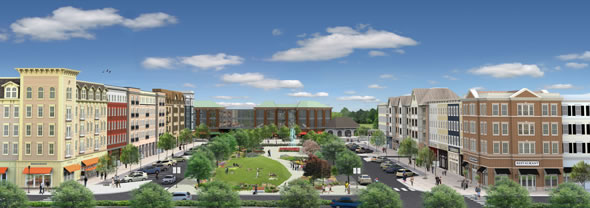This past June, 1,500 applicants contacted the owner of a new development on Long Island to express interest in just 177 apartments. The units were housed in two mixed-use buildings, which were at the time still under construction. Both with commercial space below the residences, the buildings are part of the first phase of Wyandanch Rising, a decade-in-the-making revitalization effort by the Albanese Organization that hopes to address Long Island’s acute shortage of affordable housing and revive Suffolk County’s economically distressed Wyandanch area through its transformation into a sustainable, transit-oriented community.
The Albanese Organization, designated the master developer on the project in 2011, was founded by brothers Anthony and Vincent Albanese in 1949. A full-service real estate firm with an impressive portfolio of high-profile residential and commercial developments, it is led today by the founders’ sons, Russell and Chris Albanese—chairman and president, respectively—who have carried on what their fathers began. “I think what we can trace back is our fathers really being innovators in housing, always trying to build quality and being responsible to the community we’re building in,” says Russell, whose father, Anthony, passed away in 2012. “When Chris and I joined the company, that was really at the core of what the company stood for.”
These core values—in combination with the company building energy-efficient buildings in the 1970s and ’80s and directing its focus toward developing buildings with enduring value in the ’90s—“really lay the groundwork for our approach to sustainable building,” Russell says.
Three buildings in Battery Park City set the company’s commitment to sustainability in stone, beginning with the Solaire in 2000, the first LEED Gold high-rise residential building in the country. “From that point forward, we were building more holistically,” Russell says. The Verdesian, completed in 2006 and certified LEED Platinum, was followed by the Visionaire in 2008, a collaboration between Cesar Pelli, SLCE Architects, and DeSimone Consulting Engineers that became New York City’s first high-rise condominium to achieve LEED’s highest rank. Substantially enhancing indoor air quality, the filtered fresh-air ventilation system that was introduced in the Visionaire is now standard for high-rise projects. Similarly, its stormwater-capture system has become required by New York City code.
It was their look toward communities outside of the city that led Chris and Russell to pursue the 40-acre, master-planned Wyandanch project, a public-private partnership. Located in Suffolk County, Wyandanch has long been marked by blight and disinvestment. Its benefits, however, are myriad: the community is located on the main line of the Long Island Rail Road (LIRR). “It’s less than a one-hour commute to New York City’s Penn Station,” Russell says. And it is just east of a major office corridor. These inspired a new vision for the community a decade ago, imagined by the neighborhood’s residents in partnership with local government. “[The vision] is to create a walkable community that meets the demands for rental housing on Long Island for people of all ages,” Russell says. Along with the island’s critical rental housing shortage, “there is a shortage of communities that are not totally automobile dependent.”
The first phase of the project, starting at the train station and spreading from there, includes the two aforementioned mixed-use buildings. The first, with 91 apartments, was nearing completion at the time of press; the second, with 86 units, is due for completion this spring. About 30 percent of the apartments will be rented at market rate. The rents of the other 70 percent are income-based.
Phase one also will add a public plaza, a new train station, and a new parking garage, on which the Metropolitan Transportation Authority broke ground in September. That’s not to mention a third building for office and retail space that is currently in the design phase. “I want to say it’s a new model, but it really is a model that existed in some older communities that have easy access to transit and are walkable,” Russell says, pointing to communities like Scarsdale, Bronxville, and Forest Hills. “[Wyandanch] is bringing back some of what has been done before.”
Contrasting Wyandanch to more common, low-density developments with car-dependent strip malls and general suburban sprawl, Russell says of Wyandanch: “I think it’s sustainable, it’s community-building, it’s providing much-needed affordable housing, and [it’s about] good design,” he says. “It has all the ingredients of what we want to do at the company.”



